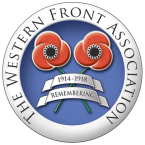‘A’ Battery, 76th Brigade, Royal Field Artillery

Albert Harry Heath was the son of Albert, the licensee of the Crown Inn, Long Street, Dursley and Anne Heath, who worked in the local telephone exchange. He was born in Dursley in the second quarter of 1890 and before the war had worked at R A Lister & Co in the town. By the time of the 1911 Census his father had died and he was living with his mother in Parsonage Street: his occupation was listed as a turner in a creamery. In the summer of 1914 he had moved to the Kilburn area of London.
In November 1914 he enlisted in the Royal Horse Artillery in London but may have transferred to the 76th Brigade, Royal Field Artillery shortly after, as from December 1914 to September 1915 he was stationed at Cork in Ireland. The brigade had been attached to the 16th (Irish) Division; part of Lord Kitchener’s ‘New Army’.
On 2 September 1915 the brigade left its base at Rollestone Camp and embarked for France via Southampton. It arrived at Le Havre on the following day and fired its guns in anger on the 10th of the month near Haverskerque. On paper each battery, ‘A’, ‘B’, ‘C’ and ‘D’ had a full compliment of 134, inclusive of four Officers and eight Serjeants, plus 125 horses. On 4 September 1915 the Brigade transferred from 16th Division to the Guards Division.
In April 1916 Serjeant Heath was severely wounded in his right eye and shoulder by shrapnel and evacuated to hospital in Boulogne. From there he was repatriated to England and sent to the 2nd War Hospital in Northfields, Birmingham. A specialist was called from London and it was found necessary to remove the eye and a one and a half inch metal fragment was taken from his throat. The Cheltenham Chronicle of 6 May 1916 reported that his first words following the operation were ‘is the gun safe?’ Sadly he failed to recover from his wounds and the operation and died in hospital on 27 April 1916, aged 26. His mother had been summoned to his bedside and it is likely that she was present when he died.
The Dursley Gazette gave a detailed description of Harry Heath’s funeral on 1 May 1916. His body was brought by train to Dursley Station and a procession led by two police constables, accompanied the coffin to the burial ground, whilst hundreds lined the street to pay their last respects. A band, made up of bandsmen from Dursley, Stinchcombe and Uley played The Dead March followed, along with a firing party from the 25th Battalion, Lancashire Regiment, stationed at an ammunition works in Gloucester. The coffin was covered with a Union Flag on which rested Harry’s cap and belt. Mourners composed of family members, volunteer soldiers, men who had attested for military service under the Derby Scheme, representatives of the Church Lads’ Brigade, Boy Scouts and many others.
A military funeral was conducted at the graveside by the Rev Dr C C Mills and at it its close the firing party fired three volleys and buglers sounded The Last Post.
Harry was described as a genial fellow, having many friends. He had been a footballer and had belonged to the Territorials. He had also been a member of Dursley Cricket Club, good as a wicket keeper and a batsman ‘of the dashing type’ who could be relied on to make runs. As an Army man he was said to have been brave and fearless, one of the best non-commissioned officers.
Serjeant Albert Harry Heath’s last resting place is in Woodmancote (St Mark’s) Churchyard, where a stone cross marks his grave. His parents are buried in the same plot. He is commemorated on the Dursley War Memorial.
Researched by Graham Adams 28 March 2013
(Acknowledgement to: David Wood; ‘Dursley 1914-18 – a study of a small town at war’ by David Evans; ‘The Long, Long Trail’ website)
